The week at a glance
- White-crowned Sparrow still in Norfolk
- Wilson's Snipe still on Scilly
- American Buff-bellied Pipit still in County Cork
- Barrow's Goldeneye still in County Down

White-crowned Sparrow, Cley next the Sea, Norfolk (Photo:
Daren Chapman)
As with so many weeks recently, it was a case of "as you were" once again as far as the headline-makers were concerned over the past seven days. But with the glimmer of spring on the horizon, there's little doubt that, soon enough, a change will come. In Norfolk, the adult male White-crowned Sparrow at Cley (Norfolk) entered its second month of residence, around the overgrown paddock across the road from the garden it originally alighted in. More bursts of song are being heard (on warmer days) and it is tempting to think that this avian superstar will feel the urge to head north within the next few weeks; indeed the bird was listed only as "reported" as being present on 5th. Even if it hasn't, or doesn't, take flight, no matter, it's more than at home with its well-honed routine. A Wilson's Snipe made it to March, still present at Lower Moors, St. Mary's (Scilly) to 5th at least. The third wintering Nearctic "mega", the first-winter American Buff-bellied Pipit, remained on parade at Red Barn Strand, near Youghal (Co. Cork) to 4th and, completing the quartet, the drake Barrow's Goldeneye remained at Quoile Pondage (Co. Down) to 5th.
It was another week of little in the way of late-winter seabirds too. A White-billed Diver remained off Port Skigersta, Lewis (Outer Hebrides) to 2nd, with three reported off Skellister, Mainland (Shetland) on 2nd. A Balearic Shearwater was seen from Seaton (Devon) on 29th.

Cattle Egret, Pwlldu Bay, Gower, Glamorgan (Photo:
Julian)
Fewer Cattle Egrets were reported this week than of late, but the nomadic shuffling around the country, for a couple of birds at least, continued. In Cornwall at least 13 birds remained around Treganhoe Farm at Sancreed to 1st at least. A single bird was still present at Stithians Reservoir to 4th. In Devon, four birds remained around the Kingsbridge Estuary to 28th, while "Leap Year Day" saw three birds appear at Westward Ho!, one remaining to the 1st. Along the north coast at Fremington, a single bird was seen on 1st, while swinging back to the south of the county, one bird was again at Warleigh Point and four birds were at Stoke Point, both on 2nd, and three were at Powderham on 5th. Up to four birds were still present at Thurloxton (Somerset) to 2nd at least, and the bird at Muchelney was still present on 2nd too. In Dorset, three birds were again seen at Radipole Lake RSPB on 29th. Singles were at Corfe Mullen and East Holme on 1st and near Abbotsbury on 3rd. Two birds remained at St. Leonards Grange (Hampshire) to 5th, and two birds were also still in place at East Lavant (West Sussex) to 5th. In East Sussex, a single bird remained at Piddinghoe to 1st, while the bird at Higher Poynton (Cheshire) was still present to 5th. New locations for lone birds this week were Pwlldu Bay, Gower (Glamorgan) on 28th-4th and alongside the Severn Estuary, at Frampton (Gloucestershire) on 28th. Have the Cattle Egrets begun to drift back to the continent or are they just drifting off the news radar and into the nearest heronry?

Glossy Ibis, Howden's Pullover, Lincolnshire (Photo:
Steve Race)

Spoonbill, Lodmoor RSPB, Dorset (Photo:
Gary Thoburn)

Great Bustard, Foss Cross, Gloucestershire (Photo:
Chris Cook)
Half a dozen Great White Egrets around the country showed little change from recent weeks. Familiar wintering birds remained at the Cotswold Water Park (Wiltshire) to 1st and at Pymoor (Cambridgeshire) to 4th. The bird at Caersws (Powys) was still present between 29th and 1st at least, and the bird seen last week at Shapwick Heath NNR (Somerset) was present from 28th-5th. The ever-elusive bird that has been in north Norfolk for much of the winter was seen at Thornham and Titchwell RSPB on 28th and in Lancashire, one was seen at Leighton Moss RSPB on 29th. Ten Spoonbills were seen at Wareham (Dorset) on 1st and then at Arne RSPB (Dorset) on 2nd. Other records from the county in the week included two still at Lodmoor RSPB and singles at Middlebere, Swineham Point and Abbotsbury. Three birds were at Pottington (Devon) on 2nd, with a single bird at Stoke Gabriel on 1st-2nd. Other singles this week were at Church Norton (West Sussex), St. Mary's (Scilly), Isle of Grain (Kent) and Cromane (Co. Kerry). The Glossy Ibis at Howden's Pullover (Lincolnshire) was still attracting birders into the new month and was still present to 5th. Over in Lancashire, the bird at Warton Marsh (Lancashire) lingered to the same date. At least 25 Common Cranes were around the Stubb Mill area of Hickling Broad (Norfolk) this week, and the single bird was again to be seen at Welney WWT to 5th. Three birds were still present near Elgin (Moray) to 4th at least, with three more still at Hastigrow (Highland) to 5th.
A Ross's Goose made a surprise reappearance at Holkham Freshmarsh (Norfolk) this week, present from 28th-5th. Another spent two days in Cumbria, at Salt Coates and then Skinburness, on 1st-3rd, with a third bird present this week, in Lancashire, at Rawcliffe Moss (a bird that may have been around for a week or so). Interestingly, a first-winter Snow Goose was seen in Cumbria, at Skinburness on 1st (alongside Pink-footed Geese and Barnacle Geese) while the first-winter bird on Orkney appeared at Kirkwall, Mainland, on 29th (with Greylag Geese). A blue Snow Goose remained at Anstruther (Fife) to 2nd at least. A "Richardson's" Canada Goose was still at Ballintemple (Co. Sligo) on 29th, with two birds there again on 2nd and one at nearby Raghly on 3rd. The adult Red-breasted Goose was back at West Wittering (West Sussex) on 29th-5th, something of a surprise bearing in mind it was last seen there on 6th February. It also popped up in Hampshire, at Hayling Island, on 3rd. Only six (perhaps seven) Black Brants were reported this week, with three along the north Norfolk coast (at Titchwell RSPB, Morston and Holkham), across the Wash at Gibraltar Point NNR (Lincolnshire), then at Kilnsea (East Yorkshire), in Sussex and at Dungarvan (Co. Waterford).
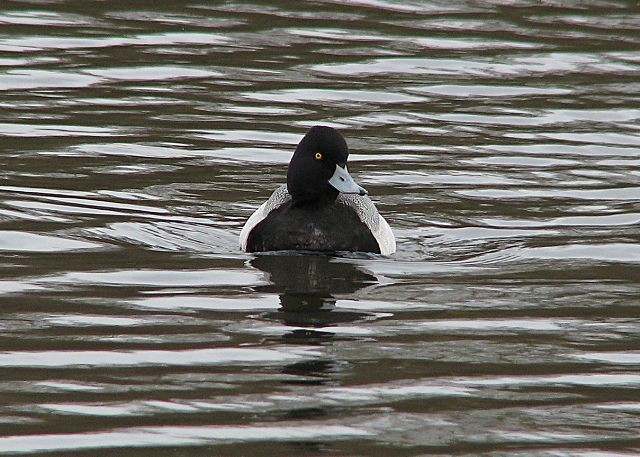
Lesser Scaup, Brandon Marsh NR, Warwickshire (Photo:
Jeff Wesson)

Ring-necked Duck, Lough Ennell, Westmeath (Photo:
Paul & Andrea Kelly)
Three drake American Wigeon were still being seen this week: at Pollyvaaish (Isle of Man), Angle Bay (Pembrokeshire) and Wick (Highland), all to 5th. A hybrid drake American Wigeon x Eurasian Wigeon was seen at Loch na Bo (Moray) on 4th. At least seven drake Green-winged Teal were noted this week; the bird at Eyebrook Reservoir (Leicestershire) remained to 29th, (and then reappeared on 5th) while the bird at Sandbach Flashes (Cheshire) made it to March (to 5th). Another drake remained at Woodhorn Flash (Northumberland) to 1st and at Marshside RSPB (Lancashire) to 5th. In Lincolnshire, one was found at Gibraltar Point NNR on 1st and the same date saw one discovered at Tacumshin (Co. Wexford). On Shetland, a Green-winged Teal was at Loch of Tingwall (Mainland) on 2nd. A drake Garganey arrived on Benbecula (Outer Hebrides) on 4th and other drakes remained at the London Wetland Centre WWT and on Castle Loch NR (Dumfries & Galloway). The latter site was host to an adult drake Lesser Scaup last week but, as photos emerged, it was clear that the bird depicted was not a Lesser Scaup. However, several people suspected that the bird in the images wasn't the bird seen first and then what was assumed to be the original bird reappeared at Loch Magillie (Dumfries & Galloway) on 3rd, and remained to 4th. Phew! The two-bird theory coming true for once! Lesser Scaup with no such worries as to their identification remained at Draycote Water (Warwickshire), Coot Loch, Benbecula (Outer Hebrides), Stourton NT (Wiltshire) and Lough Arrow (Co. Sligo). In Somerset, a drake Lesser Scaup was at Cranmore and Torr Reservoir on 2nd (and was presumably the drake seen there in November last year) and the female remained at Clea Lakes (Co. Down) on 3rd. In County Westmeath, two Lesser Scaup, a drake and a duck, were at Lough Ennell on 1st, with the female still present the following day. The same site also boasted two Ring-necked Ducks on 1st. At least six other Ring-necked Ducks were in Ireland this week: two were at Lough Arrow (Co. Sligo), another was on Lough Swilly (Co. Donegal) while three birds (adult male, adult female and a first-winter female) were seen on Doogan Lough (Co. Mayo) on 1st. In England, the drake at Foxcote (Buckinghamshire) was present to 2nd and the duck was at Stithians Reservoir (Cornwall) to 28th. The drake Ferruginous Duck was again at Craigavon North Lake (Co. Armagh) on 4th. In Devon, the first-winter King Eider remained around Northam Burrows CP until 5th, while an adult drake was seen off Uisead Point (Argyll) on 28th. A first-winter female Surf Scoter was found off West Bexington (Dorset) on 28th and was still present to 5th. The bird at Dawlish Warren (Devon) was still present to 4th, and disproved any theories that it had moved to Dorset! Two adult drakes were in Scotland, at Dornoch (Highland) on 29th-4th and off Ruddon's Point (Fife) on 1st, while two birds remained off Silver Strand (Co. Galway) to 4th. A drake Surf Scoter was off Raghly (Co. Sligo) on 3rd. Finally, a pair of Hooded Mergansers caused a minor wave of interest when birders heard about their presence at Chinley (Derbyshire) on 28th. The following day, the two birds were at Ardsley Reservoir (West Yorkshire), but moved on again by the following day. They then reappeared at Chinley on 5th, and their rings were finally seen to eliminate any hopes held out for these particular birds. That said, once the individuals seen on Outer Hebrides and Shetland have finally been accepted by the BOURC, and then open the way for the species on to the British List, every record of the species (without rings, in suitable locations at "typical" times of the year) may have more of a chance of acceptance...
The popular juvenile Rough-legged Buzzard remained around the Burnham Norton and Scolt Head Island area to 5th, while in Cleveland, the bird at Sleddale was seen again on 2nd. The Rough-legged Buzzard on Orkney remained until 3rd when one was also reported from Cumbria, at Geltsdale RSPB. Two birds were seen on the Isle of Sheppey (Kent) on 4th.

Spotted Sandpiper, Grangemouth, Forth (Photo:
Craig)
Two Spotted Sandpipers made it to March: the first-winter bird at Kinneil Lagoon (Forth) was present to 1st, while at Lisvane Reservoir (Glamorgan) the first-winter bird was still present to 2nd. The wintering Lesser Yellowlegs was still at the Montrose Basin (Angus) to 2nd and the Lesser Yellowlegs at Rosscarbery (Co. Cork) to 3rd at least. A Pectoral Sandpiper was seen at Caerlaverock WWT (Dumfries & Galloway) on 28th and could easily be the bird seen there into December 2007.

Ring-billed Gull, Strathclyde Loch, Clyde (Photo:
Lang Stewart)

Glaucous Gull, Fraserburgh, Aberdeenshire (Photo:
Euan Ferguson)

Kumlien's Gull, Larne, Antrim (Photo:
Derek Charles)
Ring-billed Gulls this week included first-winters still at Lamby Lake (Glamorgan) and Stithians Reservoir (Cornwall). The second-winter bird remained at Penrhos CP (Anglesey) to 3rd at least. An adult was at Strathclyde Loch (Clyde) to 3rd, while the adult was again in the roost at Llys-y-Fran Reservoir (Pembrokeshire) on 1st. Another adult was seen briefly at Little Marlow GP (Buckinghamshire) on 5th. Two birds (a first- and second-winter) were at Licannor (Co. Clare) on 3rd. Regular adults remained in Hampshire, Essex and County Antrim and four adults were at Nimmo's Pier (Co. Galway) on 4th. Also at Nimmo's Pier, both the adult and juvenile American Herring Gulls were still present to 5th. Around 20 Caspian Gulls were noted over the course of the past week, including five birds at Hole Haven, Canvey Island (Essex) on 29th (including four first-winters). Three different birds were seen at Minsmere RSPB (Suffolk) and noteworthy single first-winters were in Poole Harbour (Dorset) on 28th and at Rufforth (N. Yorkshire) on 3rd. Glaucous Gulls numbered around 70 birds this week, with four birds at Baile Gharbhaidh, South Uist (Outer Hebrides) on 29th, and "threes" noted at Southfield Reservoir (East Yorkshire), Hoveringham GPs (Nottinghamshire) and Cowpen (Cleveland). In Ireland, nine birds were at Killybegs (Co. Donegal) on 3rd. Once again, Iceland Gulls reached three figures in the week, with 110 or so seen. Some 40 birds were reported in Ireland, including 13 at Killybegs (Co. Donegal) on 3rd, when at least nine birds were seen Nimmo's Pier (Co. Galway). Also on 3rd, 10 birds were seen at Bay of Carness, Mainland (Orkney), a total that included four adults. Seven birds remained at Mallaig (Highland) on 29th, six birds were in the roost at Llys-y-Fran Reservoir (Pembrokeshire) on 1st and up to eight different birds roamed around west Cornwall. Several Kumlien's Gulls included an adult at Killybegs (Co. Donegal) on 29th, with two adults there the following day. A third-winter was seen at Larne (Co. Antrim) on 29th-4th, and a juvenile was at Cork City Lough on 5th. Two second-winter Kumlien's Gulls remained in County Galway, at Nimmo's Pier and Rossaveal, both on 2nd. In Scotland, second-winters were noted at Loch Ryan (Dumfries & Galloway) on 2nd-5th and at Fraserburgh (Aberdeenshire) on 2nd. A juvenile Kumlien's Gull was at Gunthorpe Pits (Nottinghamshire) on 4th. The two adult Forster's Tern remained in Ireland this week: in the north at Killyleagh (Co. Down) to 5th and in the south at Nimmo's Pier (Co. Galway) to 4th.

Waxwing, Motherwell, Clyde (Photo:
Lang Stewart)
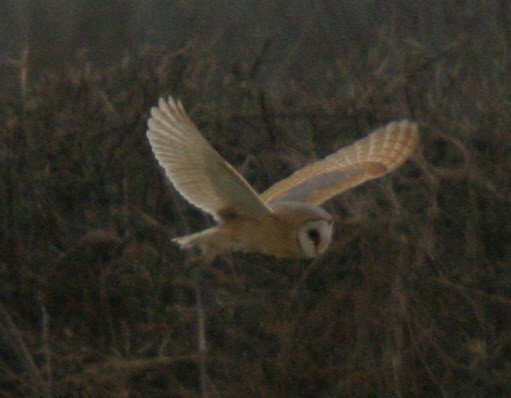
Dark-breasted Barn Owl, Wacton Common, Norfolk (Photo:
Andrew Easton)
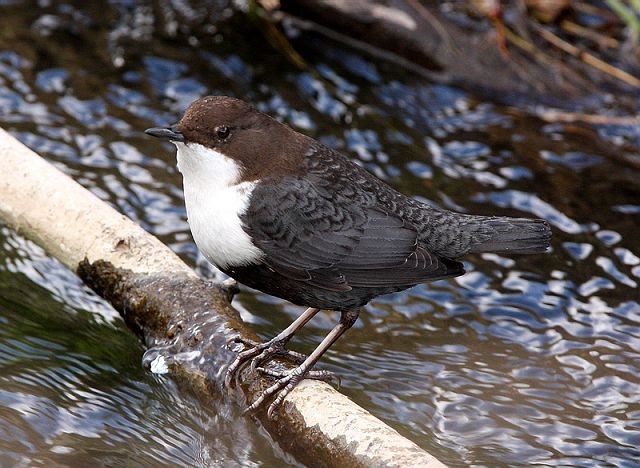
Black-bellied Dipper, Watton, East Yorkshire (Photo: Dean Eades)
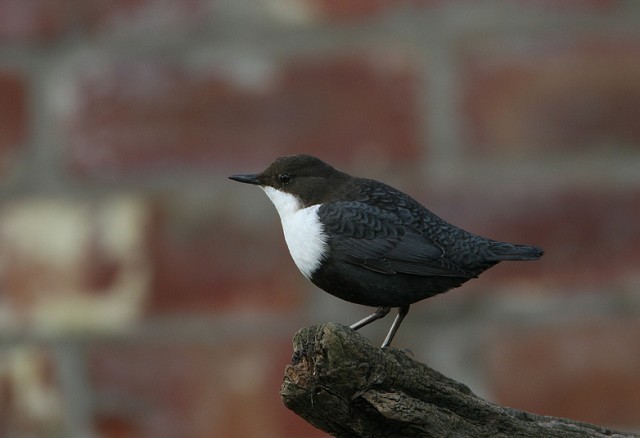
Black-bellied Dipper, Watton, East Yorkshire (Photo:
David Constantine)
In Lincolnshire, the Richard's Pipit at Howden's Pullover was still present to 4th. Fewer than 30 Waxwings were noted as the early spring approached, with 20 in Aberdeen on 2nd the largest group of the week. The handsome Dark-breasted Barn Owl remained on Wacton Common, Long Stratton (Norfolk) to 5th, while the Black-bellied Dipper at Watton (East Yorkshire) remained to 5th as well. A Hoopoe at Land's End (Cornwall) on 2nd must have been the bird seen last week at Polgigga (and was there again on 3rd-5th).
One of the Cornish Hume's Yellow-browed Warblers seemed to have gone AWOL this week, the bird at Cot Valley not reported at all, so it was down to the bird at Tehidy CP, near Camborne, to fly the flag for Kernow, present until 4th. In Stockton-on-Tees (Cleveland), the Hume's Yellow-browed Warbler remained until 3rd. Five Yellow-browed Warblers remained around the country this week, with two birds still in Devon (in Plymouth and Bovey Tracey), while others could still be found at Helston (Cornwall), Bartonsham (Herefordshire) and Jarrow (Co. Durham). The Pallas's Warbler found last week at Oakers Wood, near Bere Regis (Dorset) was still present to 2nd. At least half a dozen Siberian Chiffchaffs were reported this week, including four at Marazion (Cornwall) on 28th.

Great Grey Shrike, Budby Common, Nottinghamshire (Photo:
Darren Chapman)
Two Penduline Tits were seen again at Minsmere RSPB (Suffolk) on 26th, but there was no sign of them the following day. The Chough at Warton Crag (Lancashire) remained into March, still present to 4th at least. The Rose-coloured Starling remained in Haverfordwest (Pembrokeshire) from 28th-5th while up to 20 Great Grey Shrikes could still be found around the country, including three birds in Norfolk, with "twos" in Suffolk and Gloucestershire, as well in Buckinghamshire.
Photo of the Week

Sparrowhawk, Spital, Cheshire (Photo:
Steve Round)
Sparrowhawks polarize the opinions of birders and non-birders alike. It's certainly unpleasant to watch your cherished garden visitors being devoured on your own lawn, and equally unpalatable to learn that the rarity you were hoping to catch up with has met with the same fate. There's no doubt though that these are impressive creatures, both for their stunning appearance and for their hunting prowess. From a photographers' viewpoint, they are also difficult birds to photograph: getting close to them in an uncluttered, well-lit setting is quite a challenge. To get high quality close-ups therefore normally means having to photograph captive specimens. Steve Round's head-and-shoulders portrait would be an accomplished shot even if taken at a Birds of Prey centre, with perfect pose, composition, lighting and background. The fact that this image is of a wild bird, though, makes it quite extraordinary.
Other notable photos

Blue Tit, undisclosed site, Devon (Photo:
Chris Hill)

Bittern, Moore NR, Cheshire (Photo:
Michael Roberts)
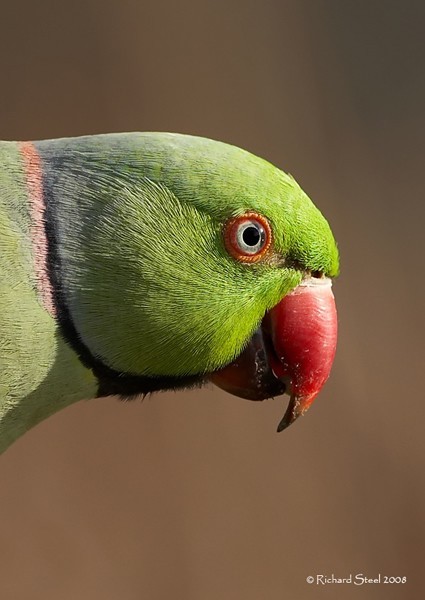
Ring-necked Parakeet, London Wetland Centre WWT, London, Greater (Photo:
Richard Steel)

Brambling, Forest of Dean, Gloucestershire (Photo:
Lewis Thomson)

Snow Bunting, undisclosed site, Clwyd (Photo:
Tom Charles)

Mediterranean Gull, Scarborough, North Yorkshire (Photo:
Steve Race)
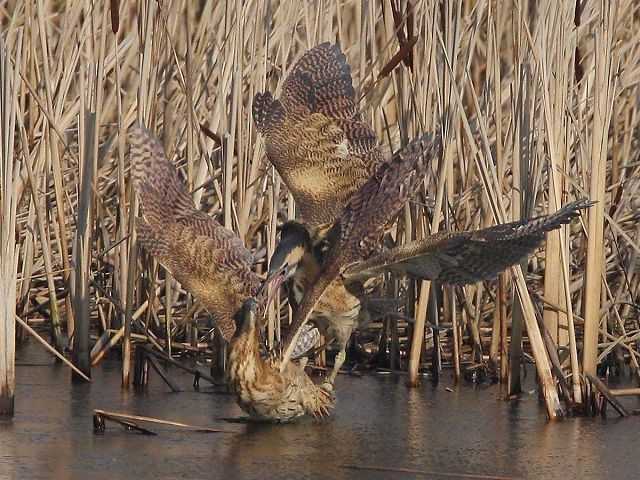
Bittern, Moore NR, Cheshire (Photo:
Michael Roberts)

Water Pipit, Leighton Moss RSPB, Lancashire (Photo:
Les Steele)

Glossy Ibis, Howden's Pullover, Lincolnshire (Photo:
Steve Race)

Green Woodpecker, St. Monans, Fife (Photo:
John Anderson)

Sparrowhawk and Starling, Wrenthorpe, West Yorkshire (Photo:
Aidan Gill)
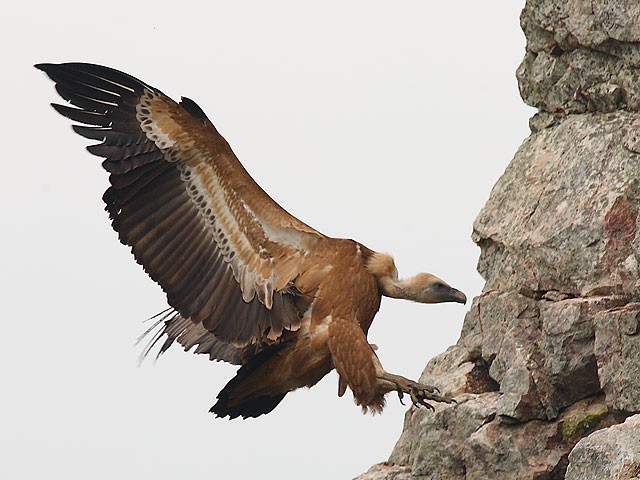
Eurasian Griffon Vulture, Spain (Photo:
Steve Fletcher)

